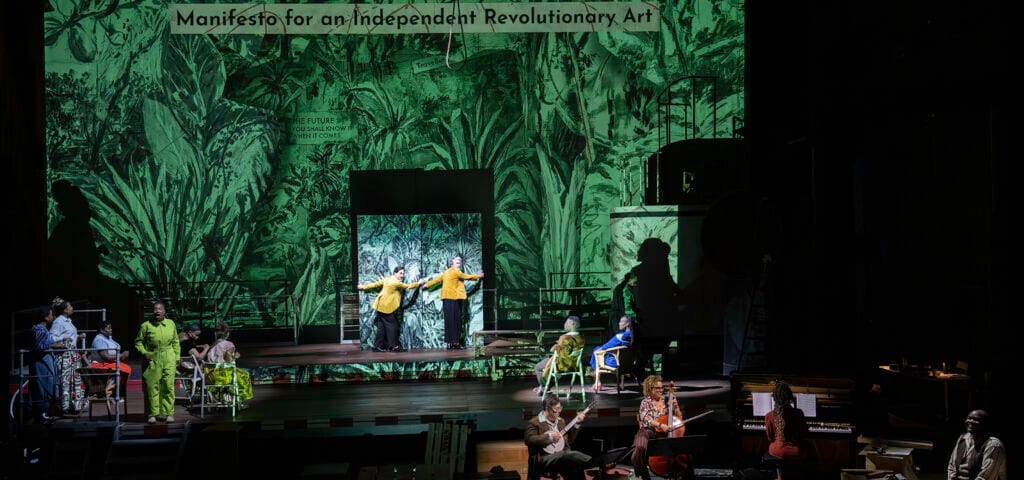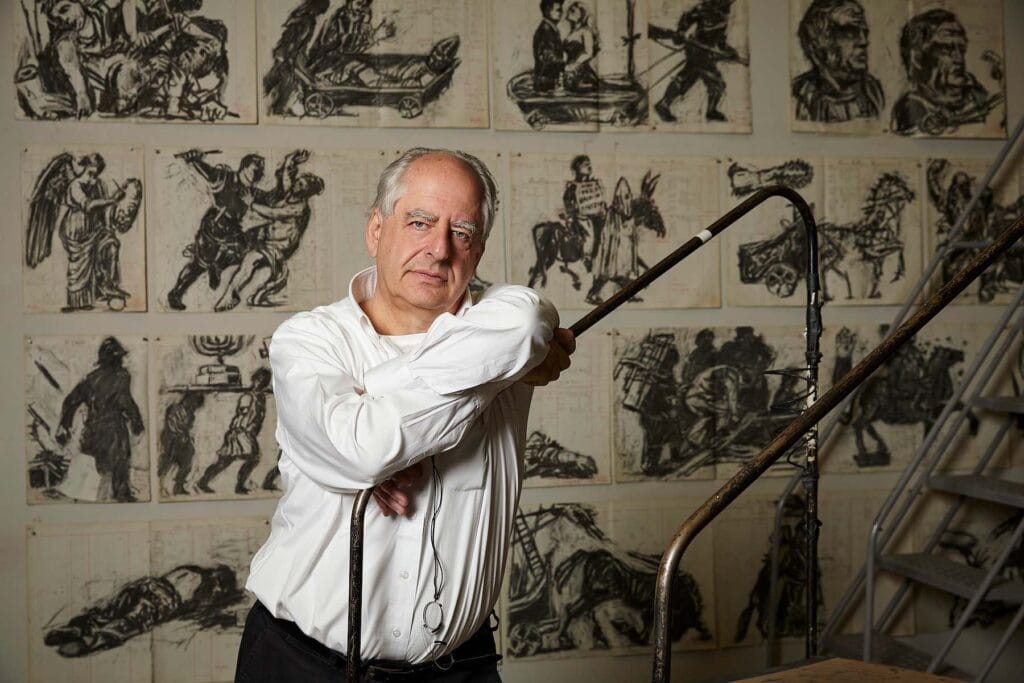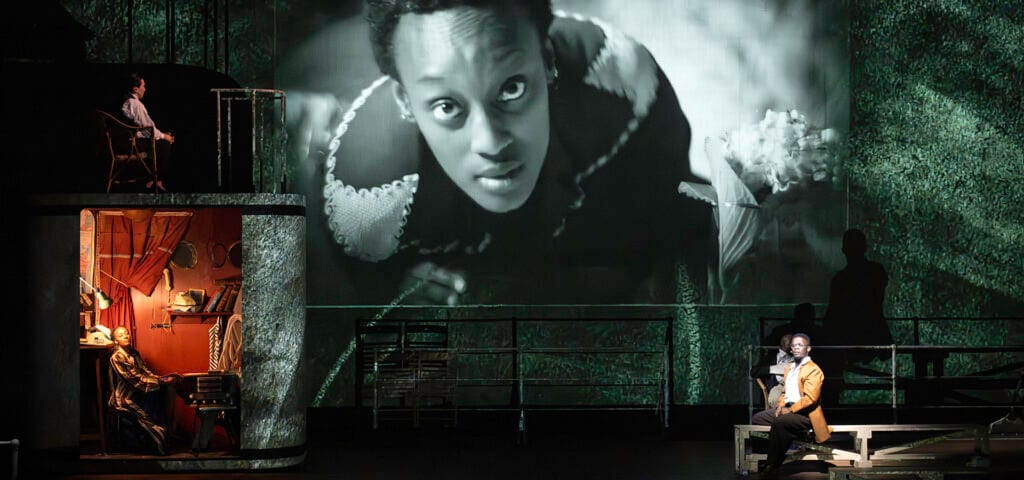By Larissa Archer
In 1941, the oceanliner Capitaine Paul Lemerle set sail from Vichy-controlled Marseille, bound for the Caribbean island of Martinique and carrying amongst its passengers various writers, artists, philosophers, engineers– a pastiche of anti-colonial refugees who “could have built the soul of a great nation.”
Several formed the founding members of the Paris-born Négritude movement. Others are seminal figures in Surrealism’s political, artistic, and literary incarnations. South African polymath of visual and performing arts William Kentridge took inspiration from this journey to create a multi-media chamber opera exploring, embellishing, and riffing on not only the journey of the Paul Lemerle and its illustrious roster but the intersection of the two movements, or at least, the irony of Europeans fleeing to their own colonies to escape the kind of violence they usually inflict on the colonized.

Cal Performances presents William Kentridge’s The Great Yes, The Great No, March 14–16, 2025 at Zellerbach Hall(credit: Monika Rittershaus)
I admit I am too pedestrian and basic to truly appreciate surrealism. I found myself wishing there were some through-line, some plot, any chain of thoughts I could follow from one to the next, anchoring all the wildness and inventiveness and beauty. The characters spoke in elegant passages taken from the writings of the literary passengers depicted, and from the poetry of other luminaries like Anna Akhmatova, Marina Tsvetayeva, Vladimir Mayakovsky, and Constantine Cavafy.
Each line was pregnant and vivid, and stood aloof from the one before it, and the one after it. Sometimes the English translations of the dialogue were painted into Kentridge’s stunning animated backdrops as the seven-woman chorus sang in languages like siSwati, isiZulu, isiXhosa, Setswana, Xitsonga, and Sepedi, or as actor Nancy Nkudi, portraying Négritude movement co-founder Suzanne Césaire, mused in her cabin on the Martinician’s experience in Europe in the most seductively beautiful French I’ve ever heard.For me, her ruminations formed the clearest statement regarding what the show was about; Europeans requiring Europeanism from non-Europeans not only in Europe but in the lands Europeans themselves flee to to escape European conflicts, leaving non-Europeans out of place both abroad, and somehow, at home as well. “Ashamed of their drawling accent, of their unrefined French, they sigh longingly for the peaceful warmth of Antillean houses and the voice of the Black “nanny” of their childhood…”
Another black passenger complains that even the way he yawns is found objectionable by European standards. One of the liberties Kentridge takes with the cast of refugees is to place on the ship certain historical figures who were not on this voyage or even alive in the same century but who were pivotal figures in both colonialist and anti-colonialist thought.

Josephine Bonaparte is one of them: born to a slave-owning family in Martinique, her lineage had been used by France’s second Empire to establish imperial rule over the island (Martinique is still an “overseas department of the French government). Russian revolutionary and thinker Leon Trotsky, assassinated by Stalin’s government before the journey which forms the basis of The Great Yes, the Great No, is another.

Pictured: William Kentridge. Cal Performances presents William Kentridge’s The Great Yes, The Great No, March 14–16, 2025 at Zellerbach Hall. Photo credit: Marc Shoul

Cal Performances presents William Kentridge’s The Great Yes, The Great No, March 14–16, 2025 at Zellerbach Hall. Photo credit: Monika Rittershaus.
The very use of Surrealism to tell this story in its evocative rather than linear way is interesting. Kentridge uses a playful combination of animation, rough sketch work, collage, and film enhanced with clever analog special effects, oversized masks, and light comedic choreography to distinguish characters, establish place and mood, and illuminate dialogue, and these devices used together do lend themselves to conveying the surreal.
There are in The Great Yes, the Great No moments of gorgeous, psychedelic surreality: its audio scape includes some of the most heartachingly beautiful choral singing I’ve heard in a theater (composed by Nhlanhla Mahlangu), exquisitely woven through with solo voice lines and supported by a four part band that incorporates noise making found objects as well as musical instruments.
In one projected film sequence, Nkudi crawls along a banquet table as fish-headed diners in tuxes and bialetti waiters seem not to notice her presence. There are two André Bretons, apparently because Kentridge enjoyed the auditions of both actors and didn’t want to choose between them, and instead had both Bretons speaking their Bretonisms to each other in dialogue (also wearing the oversized identifying masks, so we could tell which is which).
But I can’t tell if employing Surrealist principles in telling the story of this voyage helps or hinders comprehension. Surrealism was developed as a rejection of white European rationality–yet how much of a rejection is it if it’s suggesting that the obvious alternative to European rationalism is anti-rationality? As if different kinds of rationality, different kinds of thinking, and different philosophies and manifestations of wisdom didn’t exist in the very cultures that the so-called anti-Eurocentric and anti-imperialist thinkers still ignored, even while they were escaping to them in times of trouble?
In this way Surrealism was no less blinkered and arrogant than the ideologies against which it reacted. The use of the Surrealist style suggests that the story is told through a European lens, however many quotations from Afro-Caribbean writers are included.
What I do know is, my date and I, both in the late Springtime bloom of middle age, were significantly younger than most of the audience at Zellerbach Hall that night. I don’t know that anyone in the Bay Area under the age of 40 saw anything as weird and fascinating as this that weekend–I didn’t know it from the years when I had only ever seen Kentridge’s somber, darkly beautiful sketchwork animations in museums, but apparently he also specializes in creating the most balltripping WTF theater around.
It just doesn’t seem right that something so strange and exuberant is not being seen by the young. The usual issues might apply here–the expense, the extra free time for recreation enjoyed by retirees– but Cal Performances offers an excellent discounted Rush ticket program the day of performances and a 50% student discount on all tickets, and attracts artists and productions from around the world that would expand anyone’s horizons and are often more outré and daring that what can get funded here (especially now). Here’s hoping they can diversify their audience–for themselves and for us.
The post William Kentridge’s Surreal, fascinating, Multimedia, Opera at Cal Performances appeared first on Broke-Ass Stuart's Website.









